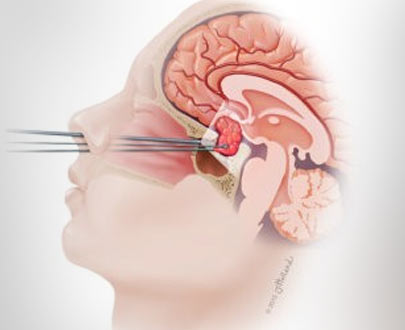Transsphenoidal Surgeon in Kolkata
Overview

Types of Transsphenoidal Surgery
-
Traditional (Endonasal) Transsphenoidal Surgery
This approach involves accessing the pituitary gland through the nose, without external incisions, and is effective for most benign tumours.
-
Endoscopic Transsphenoidal Surgery
An endoscope (a thin tube with a camera) is used for better visualisation and guidance, making it suitable for small to medium-sized tumours.
-
Microscopic Transsphenoidal Surgery
A microscope is used to magnify the tumour, allowing for greater precision when removing larger or complex pituitary tumours.
-
Transsphenoidal Surgery with Extended Approach
For larger or difficult-to-reach tumours, this approach involves removing part of the bone or using advanced tools to access the tumour.
-
Robotic-Assisted Transsphenoidal Surgery
Robotic systems assist the surgeon, providing enhanced precision and control, especially for complex or high-risk tumours.
-
Hybrid Approach (Combination of Endoscopic and Microscopic Techniques)
This combines endoscopic and microscopic techniques to improve both visualisation and magnification for better tumour removal.
Signs & Symptoms that you need a Transsphenoidal Surgery
Pituitary tumours can cause a variety of symptoms depending on the type and size of the tumour. Common signs include:

Headaches

Headaches

Vision Problems:
Blurred or double vision due to pressure on the optic nerves.

Vision Problems
Blurred or double vision due to pressure on the optic nerves.

Hormonal Imbalances
Symptoms like unexplained weight gain, fatigue, or changes in menstrual cycles due to altered hormone levels.

Hormonal Imbalances
Symptoms like unexplained weight gain, fatigue, or changes in menstrual cycles due to altered hormone levels.

Nausea and Vomiting
Caused by increased pressure within the brain.

Nausea and Vomiting
Caused by increased pressure within the brain.

Loss of Libido
Changes in sexual function due to hormone disruptions.

Loss of Libido
Changes in sexual function due to hormone disruptions.
Book an appointment today
Causes & Risk Factors of Transsphenoidal Surgery
The exact cause of pituitary tumours is not always known, but some risk factors include:
- Genetic Mutations: Conditions like Multiple Endocrine Neoplasia (MEN) can increase the risk.
- Family History: A family history of pituitary tumours can increase the likelihood of developing one.
- Age: Pituitary tumours are more common in adults, though they can occur at any age.

Diagnosis of Transsphenoidal Surgery

MRI or CT Scans
These imaging tests help identify the size and location of the tumour.

MRI or CT Scans
These imaging tests help identify the size and location of the tumour.

Blood Tests
Used to check hormone levels and determine whether the tumour is affecting hormone production.

Blood Tests
Used to check hormone levels and determine whether the tumour is affecting hormone production.

Vision Tests
Conducted to evaluate the impact of the tumour on the optic nerves.

Vision Tests
Conducted to evaluate the impact of the tumour on the optic nerves.
